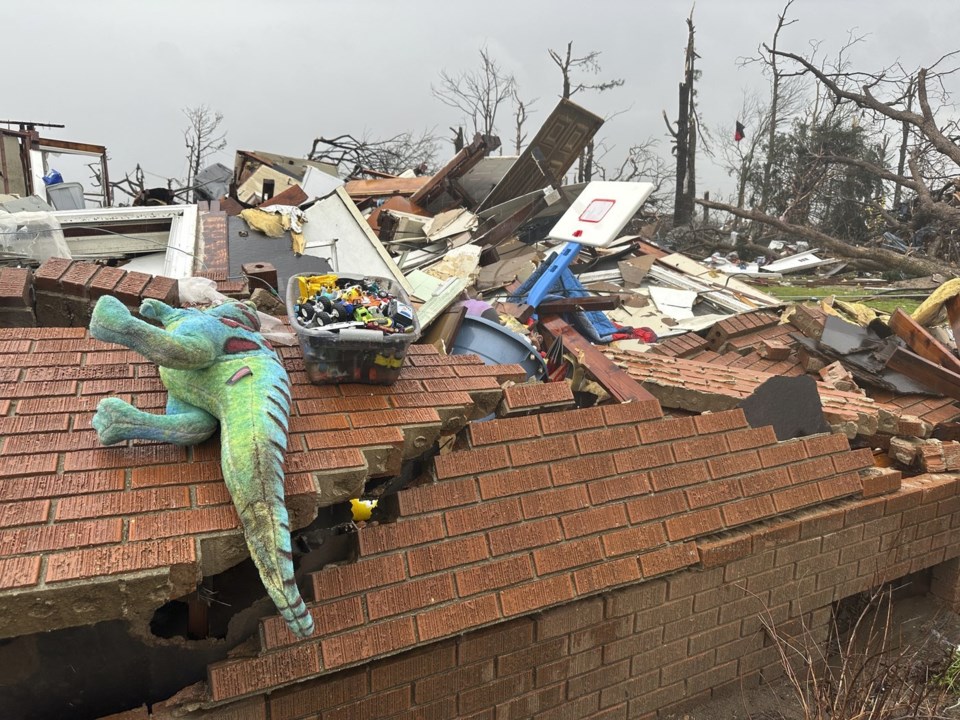LITTLE ROCK, Ark. (AP) — Parts of the South and Midwest, still reeling from violent storms, tornadoes and flooding that have killed at least eight people this week, faced an ongoing threat of catastrophic flooding Friday that forecasters said would stretch into the weekend.
Severe thunderstorms threatened a swath of the country with a population of 2.3 million people from northeast Texas through Arkansas and into southeast Missouri.
What has happened?
In Kentucky, continued storms inundated roads and a mudslide blocked a busy highway on the outskirts of Louisville. A 9-year-old boy was killed, swept away as he walked to a school bus stop.
The downtown area of Hopkinsville, Kentucky — a city of 31,000 residents 72 miles (116 kilometers) northwest of Nashville, Tennessee — was submerged.
The first wave of storms killed at least five people in Tennessee and one each in Missouri and Indiana on Wednesday and Thursday.
Tennessee Gov. Bill Lee called the devastation in his state “enormous” and said it was too early to know whether there were more deaths as searches continued.
There was massive destruction in Lake City in eastern Arkansas, where homes were flattened and cars were flipped and tossed into trees.
At least 318 tornado warnings have been issued by the National Weather Service since this week's tornado outbreak began early Wednesday, and that was likely to grow. It has already eclipsed the 300 tornado warnings issued during last month’s deadly outbreak in Arkansas, Mississippi, Missouri and other states.
Not all tornado warnings involve an actual tornado, and it was too early to know how many were actually produced by the current outbreak.
What's causing this wave of storms?
Forecasters attributed the violent weather to warm temperatures, an unstable atmosphere, strong wind shear and abundant moisture streaming from the Gulf.
The prolonged deluge, which could dump more than a foot (30 centimeters) of rain over a four-day period, “is an event that happens once in a generation to once in a lifetime,” the National Weather Service said.
What's next?
Private forecasting company AccuWeather said northeastern Arkansas, southeastern Missouri, southern Illinois, western Kentucky and northwestern Tennessee needed to prepare for a catastrophic risk from flash flooding.
“This is a rare and dangerous atmospheric setup,” said Jonathan Porter, AccuWeather chief meteorologist.
Forecasters have also warned of major disruptions to shipping and supply chains. Shipping giant FedEx, for example, has a massive facility in the danger area, in Memphis Tennessee. Barge transportation on the lower Mississippi River could also be affected.
Water rescue teams and sandbags were being set up across the region in anticipation of flooding, and authorities warned people to take the threat of rising water seriously.
“We need everyone to understand that all water poses risk right now and to take every precaution," Kentucky Gov. Andy Beshear said.
___
Associated Press writers George Walker IV in Selmer, Tennessee; John Seewer in Toledo, Ohio; Jeff Martin in Atlanta; Adrian Sainz in Memphis, Tennessee; Jonathan Mattise in Nashville, Tennessee, Seth Borenstein in Washington; and Bruce Schreiner in Shelbyville, Kentucky, contributed.
Andrew Demillo, The Associated Press



